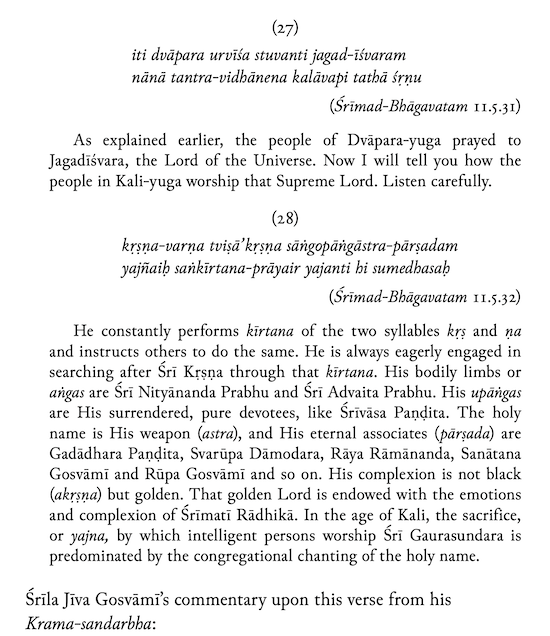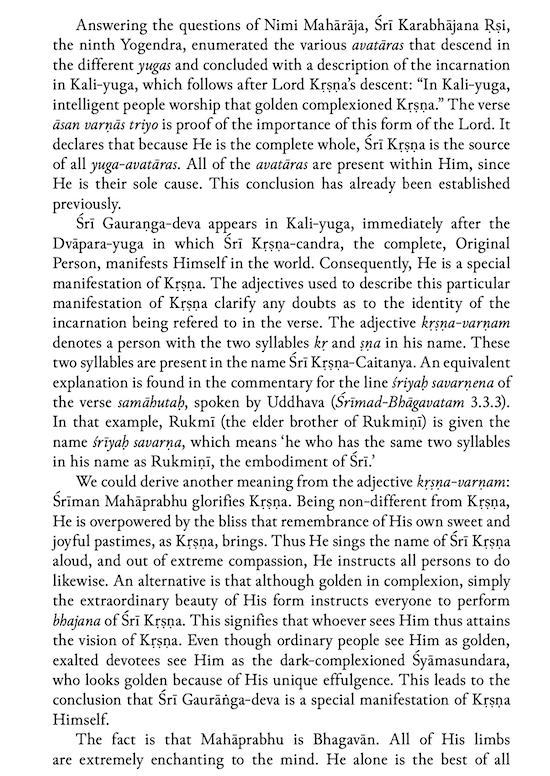Caitanya Mahaprabhu — Scriptural Proofs of His Avatarahood and Divinity. Part 8

 The chapter containing the strophe 11.5.32 of the Bhāgavata-purāṇa is a conversation between the king Nimi and nine yogendra-s. In the strophe 11.5.19, Nimi asks questions in the following order:
1. When does God come to the world of people?
2. What is his color (varṇa)?
3. What does he look like?
4. What is he called?
5. How is he worshipped?
From the strophe 11.5.21 onwards, Karabhājana gives detailed answers to Nimi’s questions in the same order: the time, the color, the form, the name, the worship rules.
In the strophes 11.5.21–23, Karabhājana describes God in kṛta-yuga as four- armed and white. The way to worship him is religious austerity, controlling one’s mind and feelings. The strophes 11.5.24–26 deal with tretā-yuga. Again, the answer begins with color: Lord was red, four-armed, with the symbols of a ladle, spoon, etc. The strophes 11.5.27–28 describe God in dvāpara-yuga: the color of his complexion was śyāma. He is a great king among mortals.
In the strophe 11.5.32, Karabhājana describes God in kali-yuga. The strophe begins with the same words about color: [Lord] is black (kṛṣṇa-varṇaṃ tviṣākṛṣṇaṃ...). However, Jīva supposes that the words kṛṣṇa-varṇa mean “the syllable ‘Kṛṣṇa’” while tviṣākṛṣṇaṃ means “shining not black [color]”. Jīva opposes black color (kṛṣṇa) to golden (gaura). This is where name “the golden avatāra” (Gaurāṅga) comes from (Krama-sandarbha commentary on the Bhāgavata-purāṇa 11.5.32). It should be noted that “golden” color and the word avatāra are not mentioned in this chapter of the Bhāgavata-purāṇa. The name of Caitanya is not mentioned in the Bhāgavata-purāṇa either.
The color of Lord in the strophes 11.5.21, 11.5.24, 11.5.27, and 11.5.32 is denoted by the word varṇa; however, Jīva’s task is to show Caitanya as the golden avatāra of Kali age, who constantly chants the name of Kṛṣṇa, so he replaces the meaning of the word varṇa with “syllable/name” in the strophe 11.5.32.
Caitanya shows reverent attitude to Śrīdhara Svāmin, who wrote a commentary on the Bhāgavata-purāṇa; he is a highest authority for Caitanya. Caitanya was generous with harsh words towards those who disregard Śrīdhara’s opinion. Śrīdhara explains the words varṇa and tvit (11.5.32) in the following way: “Like a dark sapphire that, nevertheless, shines, Kṛṣṇa also has a shining color”.
Śrīdhara does not magically transform varṇa into “syllable”. He neither sees “non-blackish” in tviṣākṛṣṇa nor considers “golden” to be the opposite of “blackish”. Śrīdhara puts it in a simple and unambiguous way: it’s about Kṛṣṇa in shining black color.
Śrīdhara’s words clearly do not fit the color pattern and “syllable” interpretation that Jīva offered for the words kṛṣṇa-varṇa: “One whose complexion is not blackish sings the name of Kṛṣṇa, he is worshipped in the age of Kali. One who is not blackish (akṛṣṇa) is the opposite of dark color (kṛṣṇa); therefore, he is golden (gaura).” Jīva Gosvāmin clearly disregarded Śrīdhara’s opinion.
This Jīva-Gauḍīya “non-blackness” appeared due to the long vowel ā at the end of the word tviṣā in the phrase tviṣākṛṣṇaṃ, where tviṣā means “color” (of the complexion) and akṛṣṇa means “non-black”. It is the long ā that allows two possible interpretations:
1. tviṣā + akṛṣṇaṃ = color + non-black (Jīva’s interpretation) or “shining + non-black”.
2. tviṣā + kṛṣṇaṃ = shining + black (Śrīdhara’s interpretation).
Grammatically, both versions are almost correct. “Almost” is necessary in this statement as far as the word tviṣā is translated as “color”. Tviṣā has meanings: “shining”, “light”, “glare” (tviṣ means “to shine”). The feminine form of tviṣ has precisely the meaning of “color”. If we ignore the form tviṣā used in the strophe 11.5.32 and replace it with tviṣ, then we can interpret it as “color”. The only conclusion we can make regarding the color is that the color is light (one of the meanings of tviṣā is “light”), for instance, light brilliant. The word tviṣā, meaning “shining”, can refer to almost any color that can shine. The color can be lighter or darker, but all this is thinking out loud about possible meanings regardless of the context. In our case, the meaning of the word tviṣā is determined by the context as well as by the order of color enumeration in the previous strophes, so the phrase kṛṣṇa-varṇaṃ tviṣākṛṣṇaṃ means “blackish, shining blackish [Lord]”.
However, Śrīdhara also has some problems. Kṛṣṇa appears only in the interpretation of the strophe, while there is no the name “Kṛṣṇa” in the strophe itself (considering Śrīdhara’s translation): “blackish, shining blackish is worshipped with saṅkīrtana…” It is unclear who exactly is blackish, shining blackish and is worshipped.
The text of the Bhāgavata-purāṇa with the version of the strophe 11.5.32 containing the words kṛṣṇa-varṇaṃ tviṣākṛṣṇaṃ is called “the northern version” or “the northern edition”, because it is spread in northern India and Bengal. This is the version of the Bhāgavata-purāṇa Śrīdhara Svāmin commented on. In the “southern” version of the Bhāgavata-purāṇa strophe 11.5.32 sounds differently:
The chapter containing the strophe 11.5.32 of the Bhāgavata-purāṇa is a conversation between the king Nimi and nine yogendra-s. In the strophe 11.5.19, Nimi asks questions in the following order:
1. When does God come to the world of people?
2. What is his color (varṇa)?
3. What does he look like?
4. What is he called?
5. How is he worshipped?
From the strophe 11.5.21 onwards, Karabhājana gives detailed answers to Nimi’s questions in the same order: the time, the color, the form, the name, the worship rules.
In the strophes 11.5.21–23, Karabhājana describes God in kṛta-yuga as four- armed and white. The way to worship him is religious austerity, controlling one’s mind and feelings. The strophes 11.5.24–26 deal with tretā-yuga. Again, the answer begins with color: Lord was red, four-armed, with the symbols of a ladle, spoon, etc. The strophes 11.5.27–28 describe God in dvāpara-yuga: the color of his complexion was śyāma. He is a great king among mortals.
In the strophe 11.5.32, Karabhājana describes God in kali-yuga. The strophe begins with the same words about color: [Lord] is black (kṛṣṇa-varṇaṃ tviṣākṛṣṇaṃ...). However, Jīva supposes that the words kṛṣṇa-varṇa mean “the syllable ‘Kṛṣṇa’” while tviṣākṛṣṇaṃ means “shining not black [color]”. Jīva opposes black color (kṛṣṇa) to golden (gaura). This is where name “the golden avatāra” (Gaurāṅga) comes from (Krama-sandarbha commentary on the Bhāgavata-purāṇa 11.5.32). It should be noted that “golden” color and the word avatāra are not mentioned in this chapter of the Bhāgavata-purāṇa. The name of Caitanya is not mentioned in the Bhāgavata-purāṇa either.
The color of Lord in the strophes 11.5.21, 11.5.24, 11.5.27, and 11.5.32 is denoted by the word varṇa; however, Jīva’s task is to show Caitanya as the golden avatāra of Kali age, who constantly chants the name of Kṛṣṇa, so he replaces the meaning of the word varṇa with “syllable/name” in the strophe 11.5.32.
Caitanya shows reverent attitude to Śrīdhara Svāmin, who wrote a commentary on the Bhāgavata-purāṇa; he is a highest authority for Caitanya. Caitanya was generous with harsh words towards those who disregard Śrīdhara’s opinion. Śrīdhara explains the words varṇa and tvit (11.5.32) in the following way: “Like a dark sapphire that, nevertheless, shines, Kṛṣṇa also has a shining color”.
Śrīdhara does not magically transform varṇa into “syllable”. He neither sees “non-blackish” in tviṣākṛṣṇa nor considers “golden” to be the opposite of “blackish”. Śrīdhara puts it in a simple and unambiguous way: it’s about Kṛṣṇa in shining black color.
Śrīdhara’s words clearly do not fit the color pattern and “syllable” interpretation that Jīva offered for the words kṛṣṇa-varṇa: “One whose complexion is not blackish sings the name of Kṛṣṇa, he is worshipped in the age of Kali. One who is not blackish (akṛṣṇa) is the opposite of dark color (kṛṣṇa); therefore, he is golden (gaura).” Jīva Gosvāmin clearly disregarded Śrīdhara’s opinion.
This Jīva-Gauḍīya “non-blackness” appeared due to the long vowel ā at the end of the word tviṣā in the phrase tviṣākṛṣṇaṃ, where tviṣā means “color” (of the complexion) and akṛṣṇa means “non-black”. It is the long ā that allows two possible interpretations:
1. tviṣā + akṛṣṇaṃ = color + non-black (Jīva’s interpretation) or “shining + non-black”.
2. tviṣā + kṛṣṇaṃ = shining + black (Śrīdhara’s interpretation).
Grammatically, both versions are almost correct. “Almost” is necessary in this statement as far as the word tviṣā is translated as “color”. Tviṣā has meanings: “shining”, “light”, “glare” (tviṣ means “to shine”). The feminine form of tviṣ has precisely the meaning of “color”. If we ignore the form tviṣā used in the strophe 11.5.32 and replace it with tviṣ, then we can interpret it as “color”. The only conclusion we can make regarding the color is that the color is light (one of the meanings of tviṣā is “light”), for instance, light brilliant. The word tviṣā, meaning “shining”, can refer to almost any color that can shine. The color can be lighter or darker, but all this is thinking out loud about possible meanings regardless of the context. In our case, the meaning of the word tviṣā is determined by the context as well as by the order of color enumeration in the previous strophes, so the phrase kṛṣṇa-varṇaṃ tviṣākṛṣṇaṃ means “blackish, shining blackish [Lord]”.
However, Śrīdhara also has some problems. Kṛṣṇa appears only in the interpretation of the strophe, while there is no the name “Kṛṣṇa” in the strophe itself (considering Śrīdhara’s translation): “blackish, shining blackish is worshipped with saṅkīrtana…” It is unclear who exactly is blackish, shining blackish and is worshipped.
The text of the Bhāgavata-purāṇa with the version of the strophe 11.5.32 containing the words kṛṣṇa-varṇaṃ tviṣākṛṣṇaṃ is called “the northern version” or “the northern edition”, because it is spread in northern India and Bengal. This is the version of the Bhāgavata-purāṇa Śrīdhara Svāmin commented on. In the “southern” version of the Bhāgavata-purāṇa strophe 11.5.32 sounds differently:
In kṛṣṇa-līlā the Lord’s complexion is blackish. A flute in His mouth, He enjoys as a cowherd boy. Now the selfsame person has appeared with a fair complexion, sometimes acting as a brāhmaṇa and sometimes accepting the renounced order of life.

